#two sides of the same coin ; new amsterdam
Text
trustschaos said:
❛maybe in some masochistic way i kind of find it all exciting.❜
The sudden admission from her whatever-they-were made Erin choke on a humourless laugh, eyes still hooded in a half-closed state from the exhaustion weighing heavily in her bones. She was dazed from the substances still mingling in her veins, alcohol and oxycodone coming together to make sure she got plenty of sleep after the adderall that kept them alert all night had begun to leave the system.
She was splayed out across her couch, barely dressed but not caring; not about the chilly air, not about the exposed skin, not about the fact that she couldn't remember the last time she ate something real. She was fine. She wasn't happy, but she wasn't sad either which was all that really counted. Lauren was company, support, comfort -- Erin didn't tell her when to stop, she didn't tell Erin when to stop. They just did what they did together, no judgement.
Never mind that recently, her most sober moments had begun to fill with emotions toward Lauren that she hadn't hoped for or expected.
"Which part?" Her words were slow, her voice drawn out and relaxed much like the rest of her, and her head lulled from side to side across the armrest of the couch. "The sober pain, the ups and downs, the amazing orgasms?"
#its not that easy for me ; erin#the downfall and the rise ; lauren#tw addiction#tw substance abuse#two sides of the same coin ; new amsterdam
2 notes
·
View notes
Text
…According to moral standards of the Enlightenment, the sophistication of one’s own education and manners should be reflected in the refinement of material possessions. Maintaining a smooth and lush lawn therefore signalled virtue, since it affirmed the essential role that discipline plays in the mastering of life itself.
Beneath the lawn lies a stratification of intricate ideological and ecological problems that over time have become naturalised. In practice, a lawn is hard to maintain. It is perennially thirsty. Fertilisers and weedkillers pollute and poison. Mowers and blowers are costly, noisy and damaging to the environment. And, crucially, lawns are the grave of biodiversity. Wildlife has little to feed on and nowhere to hide.
As climate change provides dramatic proof of our unsustainable relationship with nature, artificial turf has become a popular alternative to grass in countries that now routinely experience severe droughts. However, laying green plastic carpets made of recycled car tires over already compromised ecosystems is far from the kind of solution we need. It is becoming apparent that the lawn is a manifestation of our deep disconnect with nature: the materialisation of our lack of understanding, or care, for the complex relationships woven across plants, soil and our cultural histories.
Just as during the Enlightenment art instilled our love affair with the lawn, today’s artists are determined to untangle the complex aesthetic, ideological and ecological knots that keep our passion for mown grass alive despite mounting evidence that we’d be better off without it.
Martin Roth’s installations of Persian carpets sown with grass seeds question our desire to control nature on the grounds of our cultural conceptions and, ultimately, to disregard the natural ebbs and flows that characterise organic life. In different but related ways, Amsterdam-based artist Diana Scherer grows grass roots into patterned moulds to challenge the nature/culture dichotomy. “What does the term “natural” mean in the Anthropocene?” the artist asks through her installations and photographs. Scherer’s work reveals grasses as complex organisms whose networked existence is defined by time and space in ways that often remain invisible to us.
Pointing to ecological sustainability, in 1997 Lois Weinbergerplanted a meadow of plants that grew freely among disused train tracks in Kassel, Germany. Almost two decades later, Australian artist Linda Tegg grew a meadow of native grasses and other indigenous plants outside the State Library Victoria in Melbourne. Her project attracted wildlife to an otherwise sterile, paved urban area and envisioned a landscape in which ecological and cultural balance are two sides of the same coin.
Artists are also inviting us to rethink our relationship with the lawn from the ground up by prioritising biology over aesthetics. In Revival Field Mel Chin filled a swath of land with grasses and other plants to test their ability to absorb pollutants from soil compromised by industrial activities. In a similar vein, Frances Whitehead’s Slow Cleanup project, which ran between 2008 and 2012 in Chicago, enlisted the help of plants to regenerate the polluted soil around abandoned gas stations. Petroleum and other pollutants can be absorbed by soil microbes attracted to phenols and sugars exuded by the roots of some plants. Rather than simply providing recreational spaces, Whitehead’s new urban gardens actively engaged communities to learn about plants and ecology.
Whether addressing the implicit meaning of lawn aesthetics, foregrounding the complexity of plant life, inviting us to reconsider the importance of biodiversity in our gardens, or educating us about the regenerative properties of plants, artists (often in collaboration with scientists) have sparked our curiosity and, most importantly, demonstrated that our responsibility to care for our gardens extends beyond the wellbeing of our families. The pollinators, the water, the soil, the air, and the invisible networks of fungi and bacteria that support life on this planet matter now more than ever. No garden is too small to make a difference; it’s never too late to rewild.
Thumbnail image of Linda Tegg's Grasslands, more artists are discussed in the link.
#excerpts#rewinding#gardens#didactic art#modern art#art installations#biodiversity#anti lawn#lawns#art#environment
47 notes
·
View notes
Text
I’ll Remember You This Way
Chapter 3: 2,689
Read on AO3! (check reblog for link)
The story of one unsuspecting man named Edwin Jarvis and how his life and legacy are carried throughout the universe.
Edwin Jarvis -> JARVIS -> Vision
Snippets of that legacy include Tony Stark carrying his butler’s words in his heart for his entire life and Wanda Maximoff sensing an unfamiliar presence in Vision’s mind.
Chapter 3: it’s a beautiful new day
Edwin hates hospital waiting rooms.
He has a huge respect for the hospitals themselves, of course. It’s the actual experience of sitting in the waiting room that sends a chill down his spine.
It’s not the first time he’s been in this position; stuck in a chair with worry crushing him. Although Mr Stark prefers to call his private doctor when he falls ill, and Edwin also occasionally uses his services, Ana much prefers to physically visit the doctor. She says that it makes her feel like they’re an ordinary couple in the life they don’t have. And Edwin respects her decision.
What he doesn’t tell her is that each time he is asked to wait outside, he is transported back to that horrifying night in 1947. His whole body is shaking. The world around him is all too loud but also alarmingly quiet. His mind is completely overwhelmed with fear and anxiety. Ana is in surgery with a terrible wound, possibly on the brink of death, and he is just sitting outside in the hospital waiting room, utterly helpless. The only thing on his mind is that it’s all his fault.
Then Miss Carter is by his side, offering much-needed wordless support.
But this early morning, he is desperately trying to convince himself that Ana is perfectly fine. She has simply gone inside the room to offer support to Mrs Stark. He can hear her unusually loud voice trying to overpower Maria’s agonised screams as she calls out for Howard, despite him being on the other side of the world.
It pains him to think that this is typical of him.
“Mr Jarvis!”
The familiar click of heels alerts him to Ms Carter’s arrival. She, like all of them, looks appropriately dishevelled as she rushes towards him. “How is she? How’s it going?”
Extremely grateful to her for pulling him out of his dark thoughts in a waiting room for a second time, Edwin gestures for her to take the seat beside him. There is a sense of déjà vu.
He takes a moment to listen out for Maria’s screams, which seem to have subsided.
“I believe it’s going well.” He responds. “Ana’s inside with her now, and this is the first time it’s been quiet since we arrived. I can only think of two options as to what that could mean.”
Ms Carter lets out a strained chuckle. “Since when have you been such a pessimist, Mr Jarvis?”
Since Ana was shot and lost the ability to bear children.
She seems to read his mind and her face falls quite suddenly. She is wise to not address this though, and she decides to change the subject instead.
“Have they thought of any names yet?”
Another welcome distraction. “Maria’s quite insistent on either Antonio or Isabella, depending on the gender. They got into an argument when Mr Stark wanted the name to be American.”
“Where is Howard, anyway?”
Edwin isn’t quite sure why his chest tightens. It almost feels like anger or hatred, but not quite. More like… disappointment. “He’s currently in Amsterdam trying to settle a trade deal.”
The expression on Peggy’s face perfectly reflects his own thoughts on the matter. She scoffs. “Oh, typical Howard.”
There is a strange kindred spirit shared between himself and Ms Carter, which is odd considering that their personalities could not be more different. She is everything he isn’t; strong-willed, professional, courageous, and incredibly intelligent. She could stop a global threat in the time that it takes him to plan a dinner party. She would much rather spend an evening engaging herself decoding classified secrets whereas he would watch some television with his wife.
And yet, despite their obvious differences, they completely understood one another. Peggy often needs a break from S.H.I.E.L.D. and her busy lifestyle, which is why the Jarvis household is open to her at all times should she need it. It’s also why she comes for dinner each Sunday evening without fail. And if he is ever feeling under the weather or is having any manner of internal struggle, she picks up on it just as quickly as Ana does and checks in on him an embarrassingly large number of times until she’s convinced that he’s feeling better. Ana once described the pair as two sides of the same coin.
Edwin feels blessed to have possibly the two best women in the entire world in his life.
He is suddenly pulled out of his thoughts by Ana rushing out of Maria’s room.
Both he and Ms Carter immediately stand up. “Is she alright?” They ask simultaneously.
Ana’s hair has come loose and her eyes betray her weariness, but they are also filled with joy. “She’s fine.” She announces with a wide smile. “It’s a beautiful baby boy.”
Peggy exhales loudly with relief, and she begins to mirror Ana’s smile. “Oh, that’s wonderful! May we go inside?”
Ana falters for a brief moment. “Ah, I will have to ask Mrs Stark. I did not know you were coming, so I will ask her.” She turns to her husband. “She is asking for you, Edwin, so you can come.”
There is silence until Peggy turns to him. “Mr Jarvis?”
Edwin is frozen. It feels as if the world has stopped spinning. Mrs Stark has just had a son. A boy. A son. A child. And she is fine, and he is fine, and she’s just had a son. A brand new life.
Ana grabs his arm and starts to pull him towards the door, and only then does he snap back to reality and feels himself breathe again. As they wait for the pack of nurses to finish leaving the room, Edwin bends down to whisper into his wife’s ear the one word that has suddenly branded itself into his mind.
“Anthony.”
When they are finally let into the room, his whole body melts. All the exhaustion, anger, and sadness from last night is washed away at the sight of the little bundle in Maria’s arms. Ana senses his awe and entwines her hand with his as she leads him closer to the bed.
“How are you feeling?” He breathes.
Maria is almost unrecognisable in this state. Her hair is the messiest he’s ever seen, and she is drenched in sweat. In any other circumstance she would be furious and desperately attempt to fix herself up. But right now, she has the warmest smile on her face.
“Tired, Mr Jarvis.” She answers, her voice slurred with exhaustion and her Italian accent shining through.
She looks down at the baby in her arms, and his own eyes follow. There is a tiny mop of dark hair visible over the blanket, but he can’t see much else very clearly.
Maria seems to notice his gaze. “Do you want to hold him?”
Yes, he does want to hold him. He wants to hold him and cradle him in his arms and talk to him and cuddle him and raise him.
But he can’t seem to get the words out. Ana answers for him. “Yes, he does.”
The second that Maria hands him the child, Edwin feels warmth rush into his body. The child is awake but not crying, and he knows he will do everything in his power to keep it that way. Distantly, he hears Ana ask Maria if Ms Carter can enter, before she also instructs her to sleep. He is too busy gently rocking the child to hear the precise words spoken.
“Hello there,” he whispers, a tear rolling down his cheek, “welcome to the world, little one. You are going to grow up and be strong, smart, kind, beautiful…”
His list goes on, and he is unaware of how sadly both Ana and Peggy are looking at him.
~-.-~
Mr Stark leaps out of the car before Edwin finishes parking.
He can’t blame him. He is about to meet his son for the first time, albeit a day late, so of course he’d be in a hurry.
Edwin locks the car and rushes to follow Howard.
On the journey from the airport, Mr Stark had done nothing but chatter about this that and the other. Anecdotes from his trip, celebrity scandals, new groundbreaking ideas. He managed to talk about every topic apart from his wife and son.
An outsider may think that he was being heartless, but Edwin knows Howard well enough to know that the genius was beyond nervous and his family was actually the only thing on his mind.
Once he nears Maria’s room, he can hear the sound of raised voices coming from inside. His heart sinks. He had been positive that Mr Stark would be happy upon seeing his son but, although he cannot hear the exact words being said, it sounds like something has upset him.
Bracing himself for the worst, he lightly knocks before entering.
“I promise you Howard, that’s what I said- Edwin!”
“Edwin!”
Edwin is not at all frightened by the way both Howard and Maria’s heads instantly snap towards him as they call him by his first name. Not in the slightest. It is perfectly reasonable for them to do so and is not unusual at all.
He recovers from this initial shock to note that little baby Anthony is in his father’s arms. This immediately fills him with relief as whatever the couple were arguing about didn’t seem to involve the newborn.
With that option eliminated, his curiosity begins to grow. “Is everything alright?” He asks.
Maria sinks further into her pillow and Howard hangs his head, bringing Anthony closer to his chest. It is a concerning visual, even more concerning when Mrs Stark looks back to her husband, ignoring his question entirely.
“And you’re sure it’s too late?”
Wearily raising his head, Howard answers. “I did most of the paperwork over there. The announcement’s been made- it’s too late.”
“Too late for what?” Edwin inquires, dread pooling into his stomach. He sincerely hopes that whatever the situation is isn’t too bad.
The pair turn to acknowledge him for the first time since their initial outburst. Both of their faces seem… guilty?
Howard shuffles towards him, being very mindful of the baby in his arms. “So you know Anthony’s name, right?”
Edwin nods nervously.
“Well, there’s been a mix up.” Howard continues, his face sheepish.
“An accident.” Maria interjects. “I was exhausted, my accent was thicker than normal, and they misheard me.”
This only makes Edwin all the more worried.
Without warning, Anthony begins to wail, and Edwin instinctively holds his arms out for Mr Stark to pass the child to him. He starts to cradle him to shush him.
Howard rubs a hand over his face and takes a deep breath. “Anthony Edward Stark was supposed to be Anthony Edwin Stark.”
And if human nature hadn’t prevented him from doing so, Edwin would have dropped the baby.
He must have heard incorrectly. “P-Pardon?”
It is Maria who answers him, her expression apologetic. “We discussed this a while ago. Because we know that you and your wife can’t… have children,” Edwin bites his lip to try and prevent the tears from forming in his eyes, “and you both have been nothing but kind to us, we wanted to name our child after you. His middle name was supposed to be Edwin if he was a boy, and Ana if he was a girl.”
“But I fucked that up, too.” Mr Stark adds, but Maria just tuts at him.
“Language, Howard. We have a son now. The nurse misheard, and there is nothing we can do about it now.”
“‘Course, sorry.” Howard apologises. Then he lets out a small, pathetic laugh and a wide smile begins to grow on his face. He takes Anthony from Edwin’s arms and stares at him with an amount of adoration that is uncharacteristic for the great Howard Stark.
The same Howard Stark whose bottom lip began to tremble. Whose eyes begin to shimmer with tears. Who struggles to keep his voice even as he leans down to plant a tender kiss on his son’s forehead.
“You...” he whispers, “are hands down the best thing I have ever created, little man. You’re beautiful. God, I love you.” He turns to Edwin again, pride radiating off his face as he holds the child in front of him. “Look at my son, Jarvis! Look at him! I have a son!”
Edwin, who has been trembling all this time, matches the adoration on his employer’s face as he nods in response to the command. His mind, however, is elsewhere.
They were going to name him Edwin. The Edward mishap does not bother him in the slightest as it is the thought that counts but… they were going to name their son Edwin.
And standing there, even in front of Anthony Edward Stark’s parents, Edwin feels like a father.
~-.-~
“Shush now Anthony, your Mama will be here soon once she’s finished her very important meeting, alright? Please, shush now.”
Anthony has been wailing for the past ten minutes. And, for the past nine minutes, Edwin has been trying to calm him down. The only problem is that the only thing that will currently soothe him is Edwin’s own tie, which he very much needs and is not willing to part with. Ana made him that one.
“Awamaaaaa! Mamaaaaa!”
The ten-month old pulls himself up so that he is just-about standing in his crib with one chubby arm sticking out, trying to reach him. He has just learnt to stand, and although it makes him happy each time he accomplishes it, the fact that he has started to stand in defiance is the bane of Edwin’s existence.
With a weary sigh, he turns back from where he was about to leave and slowly crouches down so that his eyes level with Anthony’s.
“Anthony darling, your Mama will be here soon.”
“Awamamaa!”
‘Mama’ is Anthony’s first and only word, one that he’s learnt only recently. One of the maids had first heard the little boy chanting it, and had hurried to get Edwin. Edwin then commanded her to go and fetch Maria and Howard. Maria had come rushing in, but Howard had claimed to be busy.
His heart shattering at the sound of the boy’s cries, Edwin tries again. “I promise Mama’s coming.”
Anthony’s screams take on a sudden increase in volume that causes Edwin to wince.
“Waaaaaaaaah! Awamamaja! Awajaja!”
Now Edwin is by no means a young man anymore, and he convinces himself that whatever he thought he just heard was simply a trick of his imagination. Nothing more. He definitely did not just try and call out his-
“Jaja! Jaja!”
Paired with the wide brown eyes staring up at him and the arm outstretched trying to grab his tie, this time the child’s intent was unmistakable.
In his shock, Edwin says the only thing he can think of. “S-Say that again?”
“Jaja!”
“Are you trying to say… ‘Jarvis’?”
“Jaja!”
“Oh my goodness!”
Although the ‘J’ syllable wasn’t quite as clipped as it should be (sounding more like a ‘sh’) it was recognisable enough. And to say Edwin feels emotional at the fact that Anthony said his name would be an understatement.
In this time Anthony had stopped crying and instead is looking at him expectantly, as if he knew exactly what effect his words would have on him and is waiting for his reward. Edwin takes off his tie and hands it to the boy without a second thought.
He has to tell Ana. There is no time to lose. He has to bring Ana and try and get Anthony to say it again as proof that his second 'word' was a variation of 'Jarvis'.
(He feels like he shouldn’t tell Maria, and especially not Howard. ‘Dada’ is supposed to come after ‘Mama’, not the name of the family butler. This moment would be his and Ana’s private treasure- something he would confide in Anthony when the boy grew up.)
(If the boy still liked him by that time, of course.)
(Edwin hopes he will.)
#marvel#mcu#agent carter#the avengers#edwin jarvis#peggy carter#tony stark#ana jarvis#howard stark#maria stark#i'll remember you this way#fic
8 notes
·
View notes
Text
This last episode had me thinking about Villanelle and her statement "we are the same".
here you can see how true that is. They are the two faces of the same coin. They were both born with some kind of darkenss inside of them.
Oksana was raised by people acknowledging only that side. She inherit thay from her mother and all her mother showed to her was that. She was treated like she was a monster all of her life. She was taught the she was not normal but in a very negative way. She grew up sure that she didnt deserve to be loved. She was trained to be a monster and the people who trained her made sure to strio her from every last bit of hope of being loved that she had. That's when she invented Villanelle. Villanelle didnt need to be loved. Villanelle didnt care. And Villanelle was the only thing anyone ever prised and rewarded... because of her skills. Villanelle was the only part of her that people was interested in and complimented. Even if it was never with love but with money. But that was enough.
Eve on the other end was probably raised by a normal family who loved her. There is the chance se was a little bit of a weirdo but she was loved. And she showed her dark side even before Villanelle showed up. Her obsession for killer and the fascination with the way they killed. But she had always had someone casting a light on that part of her. There were shadows, yes... but there was always someone there to show her the way to the light.
Then they met.
Villanelle got obsessed cause Eve was interested in her. She was interested in her work and wanted to catch her. She was thrilled. But then something happened. The woman she was obsessed with... want interested only in Villanelle and her job. She wanted to know about her habits... about what she ate and what shampoo she used and what happened into her family. For the first time someone was seeing passing Villanelle and was looking for Oksana. For the first time she was feeling the light. Things didnt go very well then but something else hapoened. She tried to go full Villanelle again and she was successful for quite some time. But then something happened. Amsterdam. Eve let her down. And for the first time in her life she broke down. She looked at herself in the mirror and she couldnt stop the tears. And she smiled through the desperation. She was shocked and surprised. She didnt know she had it into her to feel that much. She was so used of not feeling anything that she didnt know anymore that it wasnt by nature but it was her choice. And now... those few times she had to hold back her tears had alot more sense. She was able to feel. She wasnt a machine. She was human. Yet she didnt really know anything about love. So for the second time things didnt end well with Eve. She tried to love Eve but Eve rejected her and told her that she didnt know what love meant. She then started a journey to discover what love was. She even got married. But she wasnt feeling it. Till Konstantin broke the news that Eve was till alive and she was overwhelmed once again. She was feeling again... and at the same time she was willing to understand what love really meant. And here we are... a journey that is important and yet painful... but a journey that led her to rediscover Oksana.
Eve was going through something when they met. Niko was there but she was growing bored. Bored with him, bored with her job and her life. She loved Niko but maybe it wasnt enough. And then there was this fascinations with serial killers. She probably knew it wasnt something "normal" but it was the thing that excited her the most. Then she was offered a job at MI6. She fell more and more into this spiral of obsession. Before she knew it she was already thinking about herself as the center of this female killer attentions. She wanted to be the center of her attentions. And then she was. And she was bot scared and excited about it. She was dealing with a professional assasin so to be scared was normal. But this female assassin was seeing her in a light no one ever did before. Niko loved her andbit was a gentle man. But this woman was looking at her with different eyes. She sent her gifts... she tried them on. And suddenly she saw what the assassin saw... something not even herself knew it was there. And she felt it into her whole body. When dei confronted each other for the first time... she was angry and stressed but there was no denying that she was feeling something else too. Villanelle was awakening a part of her she didnt know. She was having a sexual awakening and at the same time she was starting to aknowledge that part of her that she denied most of her life. There was a dark side of her that this lady was stirring. Soon enough it was too late to go back. She knew she had this side and she didnt want to erase it. But at the same time she had peole in herblife still casting light on her... she wasnt ready to let that side of her go either. Then things happen. She thought she had killed the assassin. She didnt. And one more she was drew to her. And she did alot to make sure she could stay in her orbit. She needed her... she wanted to feel the way V made her feel. She got to know her a bit better. The dascination grew more and more. But at the same time she was learbing more and more how dangerous this person was. Not just as a professional. She was dangerous to grow closer with her feelings too. She knew she was starting to have feelings but she knew how easily those feelings could have been crushed by a person that even trying... didnt really know how to manage them. Then it happened. She always knew she had a dark side... but never acted on it like that. But this tine she did. She killed a man. She killed him to save an assassin. But then... it wasnt really her choice. She was tricked into that when she wasnt comoletely ready to face that dark side. And she didnt want to accept it. She pushed V away. And V almost killed her. She backed away from that side. She was miserable in her attempt to a normal life. The Kenny died and a big part of the light that was keeping her alive... disappeared. And then Niko died... and she was left completely in the dark. And here we are... all that is left of Eve is her dark side. But maybe... maybe thay very woman that led her to where she is now... that woman could be the light she needs. She felt it when she saw her on the bus. She felt it when she kissed her.
When they will meet again they will know. They will know that what is left for them in the world is each other. Eve will know that Oksana is the best chance for her to still have light in her life... and Oksana will know that Eve will be the only chance for her to experience what she is craving the most... love.
i didnt mean to write this much... in my mind it was 2 sentences lol. and i am so sorry for my english lol.
#villanelle#oksana#oksana astankova#eve polastri#villaneve#killing eve#an essay basicly#ride english i know...
68 notes
·
View notes
Text
Hi! I was tagged by the hilarious and beautiful @majestic-seagull (go follow her or else). I can’t promise I can commit to the same charisma but I will attempt
Honey and lemon or milk and sugar:
Honey and lemon; I love love love honey and lemon juice is nice when am sick
Musicals or plays:
Musicals; plays are nice but adhd dictates at least once every 20 minutes something loud and obnoxious should happen for several minutes. After being around theater kids for all of high school either are awful and inescapable, might as well throw a high kick in (theater kids DNI /j)
Lemonade or unsweetened iced tea:
Uhhhhhhhhhhhhhhhhhhh, I hate lemonade (and Carrie I love you but sprite isn’t lemonade and I’ll fight you) so unsweetened iced tea, the lesser of two evils, will have to take this one
Strawberries or raspberries:
Raspberries; I love strawberries but something about them taste so weird to me I can’t get behind them wholeheartedly, raspberries tho? Timeless
Winter or summer:
I wore a dress today in 40 degree weather (Fahrenheit), and i will wear one tomorrow as it snows. Winter
Beaches or forests:
*Insert brooding-anakin.gif here*; I like the beach in theory because sometimes you see crabs and shells are pretty but forests have such power to them I cannot help but feel so much happier being in them
Diners or cafés:
Real answer? Wherever my friends are; but! Important thing to note: you cannot get a breakfast burrito sweet potato fries and strangely bad but satisfying diner coffee at a cafe (also they are much smaller and I like big space)
Unicorns or dragons:
The knight in me says unicorn, it’s what is to be strived for. But dragons objectively fuck harder, and have way more culturally different ideals and designs, so dragons (side note: jawzahr can hmu anytime 👁)
Gemstones or crystals:
Gemstones are cool, but crystals look like candy and I like to bite them, so crystals; also people who know a lot about gemstones freak me out a little lol, but anyone will see quartz and be like “pretty”
Hummingbirds or owls:
As a frog and crab lover, small and cute things that are vicious are peak aesthetic, so hummingbirds; also my grandma loved hummingbirds, and had little hummingbird things all over wherever she lived
Fireworks or sparklers:
Sparklers; fireworks are 1. Loud 2. Obnoxious 3. People don’t give a shit about anyone else and gladly freak out pets and people with ptsd like some unthinking curs (side note: can we get sparklers that don’t fizzle out after like 10 seconds?? I want to hold the flame stick for 10 minutes at least)
Brunch or happy hour:
I don’t drink anymore, so brunch; besides it’s nicer cause your friends that stay up til forever o’clock can still eat breakfast with you even though you’ve been up since like 8am lol
Sweet or sour:
Sour; I don’t really like consuming either very often to begin with, but esp with gummy candy sour is best
Rome or Amsterdam:
You think I have money to leave the country? Like at all? Like in my lifetime? To give an answer, probably Amsterdam haha weed 420 420 420 420 haha weed (also I just fucking hate Italy) (Italians DNI /j) (god help you if you’re an Italian theater kid)
Classic or Modern art:
Uhhhhhh there’s elements in both that I really like so I will not decide; I think it should be noted I only consume art, I do not know or will ever study its history (art history majors DNI /j)(god help you if you’re an Italian theater kid who majors in art history)
Sushi or Ramen:
I cannot consume anything that has touched the ocean, so ramen; I know there’s the little uzimakis and they are on thin ice
Sun or moon:
This is a question that physically hurts me. I like staring at both for long periods of time, they are my girlfriends. Both
Polka dots or stripes:
I turn 30 in 6 years, find out then
Macarons or croissants:
Croissants are just objectively better; like I enjoy a good macaron every now and then but I could eat a croissant at breakfast lunch dinner as a snack between each meal and then one after I eat dessert and not be sick of them. Also have you ever had a chocolate croissant? Bliss
Glitter or matte:
If this is about makeup, I don’t wear it but glitter; if this is about nails, also glitter
Degas or Seurat:
I flipped a coin on whether or not I wanted to learn something new right now and I will abstain on answering this question
Aquariums or planetariums:
Aquariums are nice but I always have a slight tinge of fear I’ll get murdered in the weird twisty hallways they always have, planetariums have those too but if I get murdered in them at least I can see beetlejuice, so planetariums (side note: I’ve never been to a planetarium before so if any ladies wanna take me to one and kiss me under Jupiter I would like that very much 😳)
Road trip or camping trip:
Every time I’ve gone camping it has thunderstormed, and also someone scares me, so road trip; also there’s something about pushing 100mph with all the windows down screaming Whitney Houston lyrics while your friends just beg to be anywhere else but in the car
Colouring books or watercolour:
I hate arts and crafts, with a burning passion. I can’t fold shit, I can’t color good, glue and tape get stuck everywhere and make me fucking manic. Coloring books are nice to just pretend I’m 5 years old tho, so that will be my answer
Fairy lights or candles:
Candles smell nice but fairy lights can make your backyard party from a 7/10 to an 8/10; there is no clear winner here
Wow I have to tag people now! I will now be throwing a dart (that I’m not responsible for any injuries from) at:
@mecasloth @bottled-chaos @sugaredrefrain @moofahdrome @500daysofbecky @bisexualsnufkin @esspurrr
#food#thanks again for tagging me I like remembering that people can perceive me#also please if I joked about a DNI don’t fucking clown on my post I will just block you and I’ll also probably drink your spinal fluid#/j means joking#this post is long so it will get a#long post#tag#which is like the one and only time you’ll ever get that from me teehee
4 notes
·
View notes
Note
What episode or scene made you really really start shipping Max/Helen? And why?
Episode One. lol
New Amsterdam started kind of slow for me. The pilot was a little boring and cheesy but the small exchange between the two was the highlight of the episode. It was short but I saw immediate chemistry.
By the the time he divulged to her about his cancer I was fighting it and only trying to view it through a platonic lens but the dichotomy between the Goodwins and Sharpwin was hard not to notice. He was always up in her face, the way he looked at her was passed inquisitive. And Ryan is so good with the micro-expressions. He goes there and gives similar looks to others but then he pulls back, the way he stares at Georgia and the way he stares at Helen are two sides of the same coin.
Their “friendship” after Cavitation, the one with the hug, was it for me. I was worried we were entering a situation we couldn’t get out of. He finally told Georgia but the damage was done. I really thought the intimacy would wane after Georgia found out but it didn’t.
Then there is the part Helen plays into. She NEVER mentions Akash to Max. When Helen is called out on the blurred lines and realizes she should get rid of one of the hats she wears with Max she should probably play it safe and to be honest it should be the friendship she chooses one of the professional options because their friendship, their intimacy is too important to her.
And let me say this too, the way the say “friend” to each other, is, at times, just riddled with angst. The way they say it reminds me of a broken up couple that has to reiterate to the other that they are still there for one another as friends, but it hurts because they wish they weren’t.
Finally my favorite scenes are in King Of Swords. The pining, the comfort level, the way they pushed each others buttons. The way Max adverted telling Helen exactly how he felt about her. Because they are both in too deep.
So to make a long story short I have been shipping them since episode one and it’s been growing ever since.
29 notes
·
View notes
Text
ZOOT SUIT KILLERS
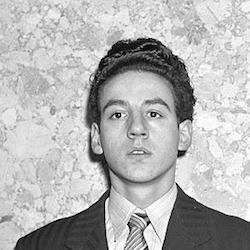
Joseph Annunziata,
On November 20 1942, a Brooklyn jury returned guilty verdicts on a pair of Williamsburg teens, 16-year-old Neil Simonelli and 18-year-old Joseph Annunziata, for the murder of Irwin Goodman, their math teacher at William J. Gaynor High School. The two of them had never much liked Goodman, a 36-year-old father of two. When he reported them to the principal for smoking in the boys' room, they walked eight blocks to Simonelli's home, where they picked up a pistol, then back to the school. They confronted Goodman and got into a scuffle with him. The gun, which Annunziata was holding, went off, perhaps accidentally, fatally shooting Goodman through the back. Because the jury entertained a doubt that the shooting was premeditated, they convicted the boys of murder in the second degree. The pair went off to Sing Sing together to begin sentences of 20 years to life. Had the verdict been first-degree murder, they could have been the youngest New Yorkers ever executed.
The city's newspapers, from the New York Times to the Brooklyn Eagle, provided extensive coverage of the case, and there was commentary in national magazines like Time. What fascinated them all, beyond the crime itself, was the boys' lifestyle and attire: uniformly, the press described Simonelli and Annunciate as "jitterbugs," "Zoot Suit Youths" and "Zoot Suit Killers."

Neil Simonelli
Whether or not anyone in the press had actually seen Simonelli and Annunziata wearing zoot suits was a moot point. By 1942, "zoot suit" was a metonym for "juvenile delinquent." What the black leather jacket and the hoodie were to later generations, the zoot suit was to the war years.
When the zoot suit first appeared it was mostly associated with black youths and the jitterbug in neighborhoods like Harlem. It consisted of an outrageously outsized jacket, with superwide padded shoulders, that hung down to the knees and the fingertips. The pants were exaggerated as well, ballooning and deeply pleated, then pegged tight at the ankles. A broad-brimmed or porkpie hat, pointed or platform shoes, a long watch chain, and a variety of tie styles completed the ensemble.
At first it was seen as a rather comical and harmless style, just another example of young people going to silly sartorial extremes. It began to look more sinister amid increasing worries about what life in wartime was doing to America's families and children.
The Depression and Dust Bowl 1930s had already wreaked havoc on the American family, turning millions into homeless migrants, splitting off husbands who went on the bum seeking any work they could find, forcing some mothers and daughters into prostitution, and enticing some young men into lives of crime and gangsterism. The war brought new dislocations and disorder. Some 15 million Americans were uprooted again, trekking across the country seeking defense work. Many moved more than once during the war, and few returned to their point of origin after it.
From 1940 well into 1943, the Selective Service exempted fathers with dependent children. But with the military's ever-expanding need for manpower, fathers eventually began to be drafted. The government started sending monthly checks to servicemen's families in 1942, but in expensive cities like New York it often wasn't enough to run a household. By 1944, more than a million servicemen's wives had taken jobs.
Kids were working too. In the Depression years, new legislation against child labor had been enacted, largely to prevent kids from taking scarce jobs away from adult males. Now, as labor shortages grew more severe, many states and localities rolled back those restrictions. As a result, by 1944 high school enrollment had fallen 25%, while the employment of youths 14 to 18 had more than doubled. An estimated 2 million high schoolers had dropped out to take jobs, and many planned not to go back to school.
The impact of all this on kids' lives could be profound. They might lose their father for the duration, or forever. They might follow their parents from one defense job to another, always the new kids in the neighborhood and at school. If they stayed in school, whether dad was gone and mom worked or both parents worked, kids now found themselves with lots of free, unsupervised time. If they dropped out and took jobs, they had cash in their pockets to spend any way they wanted.
And they were growing up in wartime. Teenage boys too young to be sent to fight knew that in a year or two or three they might well be. In the meantime they wanted to look and feel as manly as their fathers and older brothers in uniform. According to law enforcement, teenage gang activity and street fighting escalated, and the violence grew more serious; where teen gangs had formerly used fists and clubs, they now wielded zip guns and flick-knives, sometimes inflicting deadly harm. Teenage girls as well as boys took to drinking, smoking, and sexual pickups, in full eat-drink-and-be-merry mode. Adults labeled it "war degeneracy." It's no coincidence that the terms "youth culture" and "teenager" (or "teen-ager") were also coined in this period. They were something new, a generation of latchkey kids, army brats, war orphans.
The story of Simonelli and Annunziata neatly encapsulated what was seen as a broader trend. Youth crime figures in the first full year of the war were so disturbing, J. Edgar Hoover said, that a "counter-offensive" was necessary to prevent "a breakdown on our home front." He told a graduating class at the FBI Academy, "Something has happened to our moral fibers when the nation's youths under voting age accounted for 15 per cent of all murders, 35 per cent of all robberies, 58 per cent of all car thefts and 50 per cent of all burglaries." Later studies showed that nationwide juvenile delinquency arrests rose 72 per cent during the war. In Brooklyn, it was 100 per cent.
By 1942, the year of Simonelli and Annunziata, the zoot was identified as much with this behavior as with lindy-hopping and jitterbugging. That year, the War Production Board actually declared the zoot suit unpatriotic, because it was a waste of material in a time of rationing. The wide, pleated skirts girls wore for jitterbugging (and showing off their underwear) were denounced on the same grounds.
In 1943, one in five arrests was of someone under 18. But that year offered clear evidence that at least some of those arrests were the result of harassment and bias as much as bad behavior. That June, white sailors and soldiers in Los Angeles went on a rampage, attacking Mexican American teens all over the city. The "pachucos" fought back, and a week of rioting followed. The national press, against all evidence that the white servicemen had instigated a race riot, chose to call it a "zoot suit riot."
A new raft of stories followed, as journalists competed to define what the zoot was, what it meant, who wore it, and who invented it. Claimants to the latter ranged from a busboy in Atlanta to tailors in Memphis, Chicago, and L.A. The New Yorker, not surprisingly, decided that it started in Gotham. "With some friendly cooperation from the editors of the Amsterdam News, an uptown newspaper published by and for colored people, we got in touch with Lew Eisenstein, proprietor of Lew's Pants Store, on 125th Street," a "Talk of the Town" piece called "Zoot Lore" explained that June. Supposedly Lew's wife first pegged some loose pants in 1934, and the rest of the zoot suit followed in due course. Lew took credit for adding the long watch chain. Their claims were, of course, disputed by others.
The zoot suit would live on past the war, mostly worn by black and Hispanic men, though the influence of its wide shoulders and voluminous pants could be discerned in all men's suits in the early 1950s. Concerns about juvenile delinquency also continued after the war, rising to a level of national panic in the 1950s.
The story of the zoot suit killers lived on in its own way. In 1947, Irving Shulman's pulp novel The Amboy Dukes, set in wartime Brooklyn, was a shock sensation, selling five million copies even as it was banned in some locales for its sex and violence. Schulman, who was from Brooklyn himself and spent the war years writing for the War Department in Washington, clearly used Simonelli and Annunziata as the models for his lead characters Frank Goldfarb and Benny Semmel. They're a pair of juvenile delinquents in Jewish Brownsville, products of its "ugly gray and red tenements, tombstones of disease, unrest and smoldering violence… It was as if nothing bright would ever shine on Amboy Street." While their parents do defense work, Frank and Benny hook school almost constantly to hang out with their gang, the Amboy Dukes. They make money selling counterfeit gas ration coupons on the black market, and spend it on liquor, marijuana, zip guns and whores. They too accidentally shoot and kill a teacher in a scuffle, and come to a worse end for it than their real-life models.
Lurid yet relentlessly downbeat, The Amboy Dukes both looked back to the worst of wartime New York and ahead to 1950s juvenile delinquent tales like Blackboard Jungle and Shulman's own Rebel Without a Cause. (He would also write a novelization of West Side Story.) After the scandal kicked up by its first appearance, later editions dialed back the sex and violence and, interestingly, deracinated the two anti-heroes by giving them less Jewish-sounding surnames. In 1949 it was adapted for the film City Across the River.
by John Strausbaugh
13 notes
·
View notes
Photo

ALESSANDRA LACROIX --
Birthdate: September 1st, 1989 ( 28 )
Gender and Pronouns: Female, she/her
Hometown: New York, New York
Neighborhood: Upper West Side, Manhattan
Occupation: Owner of Soirée
Faceclaim: Phoebe Tonkin
Trigger Warnings: Amnesia, Car Crash, Coma, Death of a Sibling.
BIOGRAPHY --
As a little girl Alessandra Renee Lacroix was the type of daughter that parents bragged about. With big hazel eyes, manners that only a proper politicians daughter could be equipped with, and a contagious smile she was not only the apple of her parents’ eyes but anyone who was lucky enough to cross her path. The only Lacroix daughter had a way of wrapping people around her tiny pinky finger. Not that she ever noticed or cared for that fact much. No the only thing that mattered to young Alessia was making friends. Even at a young age her biggest hobby came in the form of collecting people the way one would collect coins. And with two siblings who were often preoccupied with things Alessia held no interest for, people were often the way she chose to entertain herself because unfortunately barbie dolls and princess puzzles could only interest the little girl for so long before she went wandering around the manor. From the time she could understand others and talk Scar was making friends. First it was the workers that worked within her family’ home. Constantly chattering with the maids and other help. Then it was her father’s visitors, charming them in the parlor with her cute stories before she gradually moved up towards her mother’s far more sophisticated friends.
But often times Alessia just watched people. Their mannerisms, the things that made them laugh or made them angry, and most importantly their secrets. Because as she learned early on, it was easier to make people like you when you knew exactly what strings to pull. Everyone she met, from maid to politician to socialite was as interesting as the other. And when she was eventually brought back into her room to play with her dollies she’d pull inspiration from the stolen interactions or glances at the people in her very own home. A talent that Isabelle Lacroix found far from charming as she watched her daughter perform “plays” with exact quotes from things she hadn’t even realized the little girl had been around for. Worried that her daughter’s knack for sticking her nose in places it didn’t belong would get her in trouble the woman enrolled the then four and a half year old into her first ballet class. Immediately it became apparent to both Alessia’s teacher and her parents that the young girl had a natural talent for the dance, a trait she likely had inherited from her world renowned retired prima ballerina grandmother Josephine Lacroix. Prancing around in tutus with some of her best friends in the world had been fun at first. She found joy and excitement in being able to master a new piece of choreography and perform it for not only her instructor and parents but her friends at school. Somewhere along the way however the fun hobby stopped being seen as a hobby to the adults in her life. The moment Josephine Lacroix had taken over for Alessia’s dance lessons everything changed. Suddenly the eight year old was being signed up for competitions and recitals. When she won or performed well, she’d be praised for weeks. When she lost or performed poorly, she’d be reprimanded for months.
Her grandmother was determined to make a prodigy out of her granddaughter and the more the woman pushed the harder out of love Alessia fell for dancing. She no longer had fun learning new moves or performing them but despite her admitting as such to her parents, she was pushed onward because in the Lacroix family talent of any kind wasn’t meant to be wasted. By the time Alessia reached middle school she’d built up too many years of resentment not to rebel. As graceful with her words as she was with her legs she quickly climbed her way to the top of her food chain at her prep school. Happily accepting the attention and limelight while her siblings took a far more humble road. Yet even then, with her unnecessary need to be doted on, Alessia had been kind, giving back the attention given to her tenfold because if anything still remained true about her, it was her genuine love for people. By sophomore year she was already friends with every soul in the class with intentions to quickly work her way through the faculty and staff. Anyone was worthy of her friendship and like the true daughter of a politician, she did everything possible to keep from having any enemies. And it was something that reigned true about the girl until about halfway through her junior year when her beloved older brother Jasper Lacroix died at the age of twenty-one after being involved in a fatal car crash.
Out of all mentor figures in her life Jasper was the one Alessia felt the closest to; seeing as her eldest brother was the shield that protected the rest of the Lacroix children from the brute of their family’s unobtainable expectations. He’d also taken it upon himself to integrate into the life of his siblings. Finding ways to not only watch over them but bond with them as well. With parents who were often too busy to take her to every dance practice, it quickly became a number one task for Jasper and every Monday, Wednesday, and Friday at 4 o’clock sharp he’d be at the door waiting to do the thirty-minute drive to and from her lessons. Even going above and beyond by staying through the whole practice to watch and cheer her own through the glass doors. Alessia hadn’t simply lost a sibling but an ally and her closest friend. A sentiment her grandmother clearly hadn’t understood because as sixteen year old Alessia openly wept for her brother at his funeral, she was met with an angry matriarch pulling her aside and telling her to man up, “Your brother, god bless his soul, babied you and made you soft but Alessandra Renee Lacroix, I will do no such thing. You will stop crying and you will stop it right now. Strong women do not cry, they do and when there is nothing to do, they accept. He is gone, accept it and move on.”
In hindsight, her grandmother likely hadn’t meant to be so harsh. It was very possibly that she herself was trying to appear strong and put together for her family and having to hear her granddaughter wailing was doing very little to help her keep it together and she just cracked. There are a lot of possibilities, but the results were the same nonetheless and Alessia was never the same again after that discussion. Strong women do not cry. Your brother made you soft. Words that haunted the girl amidst her grief until she decided to take her grandmother’s advice. Strong women didn’t cry, they do. And she did. For the next year and half Alessia Lacroix transformed herself into the model of a horrible daughter and granddaughter. Doubling down on her partying, plumbing her grade point average, she even started skipping her ballet practices and recitals. Josephine Lacroix couldn’t have been more livid that she had seemingly lost all control of her prodigy. The more Alessia rebelled, the more of a lost cast Josephine regarded her as. And in some ways that’d been true, but not entirely.
Alessia’s madness came with a method. Breaking all the rules her family had ever set for her had been the only way she saw fit to get what she truly wanted, freedom. By the end of senior year her father and grandmother had given up entirely on the idea of reigning her in and Scarlett was left to do as she pleased as long as she kept the family name out of the tabloids for unbecoming reasons. A promise Scarlett had no problem keeping as she boarded a flight to her first out of many European countries. It wasn’t long before Europe wasn’t enough for her and Scarlett began to travel the rest of the world. South Africa. Japan. Bali. Mumba. Morocco. South Korea. Moscow. Stockholm. Amsterdam. And so much more. The decision to start an Instagram account two years after she began travelling had been one made on a whim but it didn’t take New York native long to gain a following. Her account caught the eye of some scouts as well which started her very short lived modeling career. Six months after signing with her first agency Alessia quickly realized that despite her mother having been able to make a career out of it, the world of modeling wasn’t for her. Though that hardly meant her popular Instagram account was done opening doors for her. The first time Alessia planned an event it had been a birthday vacation with her friends. She booked the tickets, tracked down the best hotel, and mapped out their entire Italian summer adventure without so much as batting an eyelash. That soon led to her planning things other than fabulous vacations. Birthday parties. Networking events. Bridal showers. Engagement parties. Etc.
Before Alessia knew it she’d become the go-to girl for Instagramable events of all kinds. Pretty soon the demand surpassed the supply and she found herself flying back to Manhattan to think about turning her accidental hobby into a business. Having forgone college and generally hating anything that meant dealing with numbers Alessia found herself a business partner who could handle the paperwork aspect of starting a business while she focused on the creative end. Within a span of a few months Soirée was a reality and in just five years it became one of the most successful and highly sought after event planning companies in New York. With Alessia’s clientele spanning from close friends to those who found the company though one of their many social media accounts. With her career skyrocketing the last thing Alessia expected was for her love life to fall into place as well, after all woman couldn’t have it all. That’s what she’d always been told but Steve Vicari was everything she hadn’t know she was looking for.
He wasn’t like the egotistical spoiled rich boys of her past. He didn’t play games. And everything about him dripped in a genuineness that was rare in the world she came from. Cupid’s arrow had hit and Alessia was in love. Three years after meeting they were engaged and happily ever after seemed to be just around the corner when their wedding day approached. The last thing on her mind that day had been running away but after her father entered her dressing room only moments before she was due to walk down the aisle to proclaim his disapproval of who she was choosing to marry, things went downhill. When Alessia refused to allow her father’s negative words about her “lower-class lover” to effect her, he threatened to expose something dark from her fiancee’s past if she decided to ignore his wishes and marry the man anyway. Feeling as if she had no choice Alessia barely made it five steps down the aisle before turning in the option direction and running to the car ironically married just married to make her get away. She pulled away from the hotel and then was met with utter blackness after a truck collided with the sports car. Two months later Alessia Lacroix awoke from a coma with no memory beyond her sixteenth birthday.
PERSONALITY --
( + ) ambitious, charismatic, loyal.
( - ) neurotic, rebellious, stubborn.
1 note
·
View note
Text
Physicists excited by discovery of new form of matter, excitonium
Excitonium has a team of researchers at the University of Illinois at Urbana-Champaign... well... excited! Professor of Physics Peter Abbamonte and graduate students Anshul Kogar and Mindy Rak, with input from colleagues at Illinois, University of California, Berkeley, and University of Amsterdam, have proven the existence of this enigmatic new form of matter, which has perplexed scientists since it was first theorized almost 50 years ago.

The team studied non-doped crystals of the oft-analyzed transition metal dichalcogenide titanium diselenide (1T-TiSe2) and reproduced their surprising results five times on different cleaved crystals. University of Amsterdam Professor of Physics Jasper van Wezel provided crucial theoretical interpretation of the experimental results.
So what exactly is excitonium?
Excitonium is a condensate -- it exhibits macroscopic quantum phenomena, like a superconductor, or superfluid, or insulating electronic crystal. It's made up of excitons, particles that are formed in a very strange quantum mechanical pairing, namely that of an escaped electron and the hole it left behind.
It defies reason, but it turns out that when an electron, seated at the edge of a crowded-with-electrons valence band in a semiconductor, gets excited and jumps over the energy gap to the otherwise empty conduction band, it leaves behind a "hole" in the valence band. That hole behaves as though it were a particle with positive charge, and it attracts the escaped electron. When the escaped electron with its negative charge, pairs up with the hole, the two remarkably form a composite particle, a boson -- an exciton.
In point of fact, the hole's particle-like attributes are attributable to the collective behavior of the surrounding crowd of electrons. But that understanding makes the pairing no less strange and wonderful.
Why has excitonium taken 50 years to be discovered in real materials?
Until now, scientists have not had the experimental tools to positively distinguish whether what looked like excitonium wasn't in fact a Peierls phase. Though it's completely unrelated to exciton formation, Peierls phases and exciton condensation share the same symmetry and similar observables -- a superlattice and the opening of a single-particle energy gap.
Abbamonte and his team were able to overcome that challenge by using a novel technique they developed called momentum-resolved electron energy-loss spectroscopy (M-EELS). M-EELS is more sensitive to valence band excitations than inelastic x-ray or neutron scattering techniques. Kogar retrofit an EEL spectrometer, which on its own could measure only the trajectory of an electron, giving how much energy and momentum it lost, with a goniometer, which allows the team to measure very precisely an electron's momentum in real space.
With their new technique, the group was able for the first time to measure collective excitations of the low-energy bosonic particles, the paired electrons and holes, regardless of their momentum. More specifically, the team achieved the first-ever observation in any material of the precursor to exciton condensation, a soft plasmon phase that emerged as the material approached its critical temperature of 190 Kelvin. This soft plasmon phase is "smoking gun" proof of exciton condensation in a three-dimensional solid and the first-ever definitive evidence for the discovery of excitonium.
"This result is of cosmic significance," affirms Abbamonte. "Ever since the term 'excitonium' was coined in the 1960s by Harvard theoretical physicist Bert Halperin, physicists have sought to demonstrate its existence. Theorists have debated whether it would be an insulator, a perfect conductor, or a superfluid -- with some convincing arguments on all sides. Since the 1970s, many experimentalists have published evidence of the existence of excitonium, but their findings weren't definitive proof and could equally have been explained by a conventional structural phase transition."
Rak recalls the moment, working in the Abbamonte laboratory, when she first understood the magnitude of these findings: "I remember Anshul being very excited about the results of our first measurements on TiSe2. We were standing at a whiteboard in the lab as he explained to me that we had just measured something that no one had seen before: a soft plasmon."
"The excitement generated by this discovery remained with us throughout the entire project," she continues. "The work we did on TiSe2 allowed me to see the unique promise our M-EELS technique holds for advancing our knowledge of the physical properties of materials and has motivated my continued research on TiSe2."
Kogar admits, discovering excitonium was not the original motivation for the research -- the team had set out to test their new M-EELS method on a crystal that was readily available -- grown at Illinois by former graduate student Young Il Joe, now of NIST. But he emphasizes, not coincidentally, excitonium was a major interest:
"This discovery was serendipitous. But Peter and I had had a conversation about 5 or 6 years ago addressing exactly this topic of the soft electronic mode, though in a different context, the Wigner crystal instability. So although we didn't immediately get at why it was occurring in TiSe2, we did know that it was an important result -- and one that had been brewing in our minds for a few years."
The team's findings are published in the December 8, 2017 issue of the journal Science in the article, "Signatures of exciton condensation in a transition metal dichalcogenide."
This fundamental research holds great promise for unlocking further quantum mechanical mysteries: after all, the study of macroscopic quantum phenomena is what has shaped our understanding of quantum mechanics. It could also shed light on the metal-insulator transition in band solids, in which exciton condensation is believed to play a part. Beyond that, possible technological applications of excitonium are purely speculative.
Top image: U of I Professor of Physics Peter Abbamonte (center) works with graduate students Anshul Kogar (right) and Mindy Rak (left) in his laboratory at the Frederick Seitz Materials Research Laboratory. Photo by L. Brian Stauffer, University of Illinois at Urbana-Champaign
270 notes
·
View notes
Text
Italy: like putting on an old boot

Since losing my passport in Madrid, I had a two-week window before our next trip to get a new one. I ended up going to the US Consulate in Amsterdam, which was an adventure all in its own. If you picture the DMV, but on ‘roids, that is about the experience of applying for a passport abroad. After getting a new passport photo, I got to wait outside the building on the literal coldest day of the year for an hour before being ushered through security in order to wait for another two hours interspersed with quick trips up to the counter to explain that I don’t know what happened to my passport because I lost it and then being chastised for losing my passport because I must look too young to possibly be able to comprehend the gravity of importance such a document. Oh, and I had to pay $140. But luckily the US is very efficient at printing rush order passports and it arrived the following Friday, just in time for our trip to Rome. But of course, there would be one more hiccup in the story- the city lost power on Friday afternoon when I planned to pick up my passport. So the Consulate did not have power… or at least the backup generator did not power the whole building. Luckily, the guards were able to just grab the newly printed passports (I was not the only one trying to pick one up that day), and I was on my way.
Once we got into Rome, the same feeling of joy I had from my first visit washed over me, and I think I had a smile on the whole weekend. Rome is a huge city, so it is crowded, busy, smelly, full of trash, a bit rundown, etc. However, I love it for the amazing art, culture, and food. What can I say, Rome was the center of Western culture for much of history, and for much of my Catholic upbringing (and my brief stint as a Latin nerd), so it generates some degree of awe.

We threw in our coin, so I guess we’ll be back again
We checked into our hotel, which was across from some state building. When checking us in, the clerk said if we take photos from the window, the state employees might think we are spies and send people over to the hotel to investigate. I’m pretty sure he was joking? Mariah may have tested the theory the next evening after a few drinks.
We went to dinner that evening and tried some authentic Roman dishes, including an artichoke sampler platter. To be honest, steamed artichokes and butter was one of my sister’s favorite meals growing up, but they were never one of mine. But the Roman style artichokes blew me away. They are originally prepared by Jewish immigrants, but were quickly adopted by the Roman locals, so much so that Rome is one of the largest artichoke producers in the world. The Jewish version is lightly battered and fried, while the Roman version is steamed, and both are incredible. I also had pasta al’amatriciana (tomato sauce with pork cheek) and Mariah had ravioli before we split an incredible tiramisu. Before calling it a night we walked over to the Trevi fountain and threw in a coin. I guess we’ll be back one day.

Magical artichokes

We had some super delicious pastries in our hotel the next morning before heading to St. Peter’s Basilica. After taking some initial photos, I was talked into upgrading our museum tickets to a guided tour. While this is expensive, it is worth it- the guide is great, but you’re really paying to skip the 3+ hour line to see the basilica from the museum (and Sistine Chapel). We learned why the Vatican is its own country (long, convoluted story short- the modern church never wanted to join the united Italy, and the arrangement stuck- helps when you have your own private army). The Vatican treasures are as incredible as they are extensive. We saw Greek/Roman gods, human personifications of the Tiber river, supposed tombs of Helena and Constantina (mother and daughter of Constantine), maps of the world, paintings and tapestries for days, and a Roman Zach Galifianakis. But this was all a lead in to the Sistine Chapel, of Michelangelo fame. Of course there are no photos, but the Creation of Adam and the Last Judgment are every bit as amazing as hyped. We then fast tracked to the staggeringly beautiful St. Peter’s basilica. We saw the tombs of the popes (St. John Paul II has his own chapel on the main floor) and the Pieta, but my favorite is the altar from Bernini. Just look at the pictures.

St. Peter’s Basilica

Is that you, Zach?
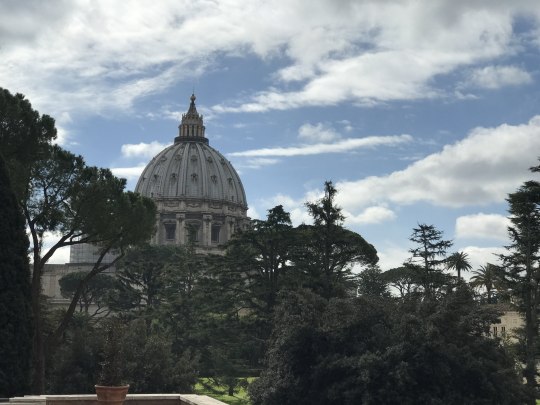

Pieta
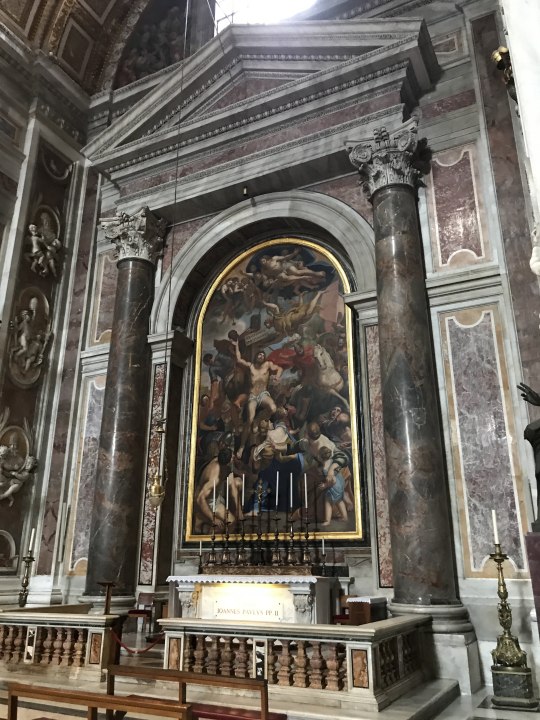
Pope JPIII!
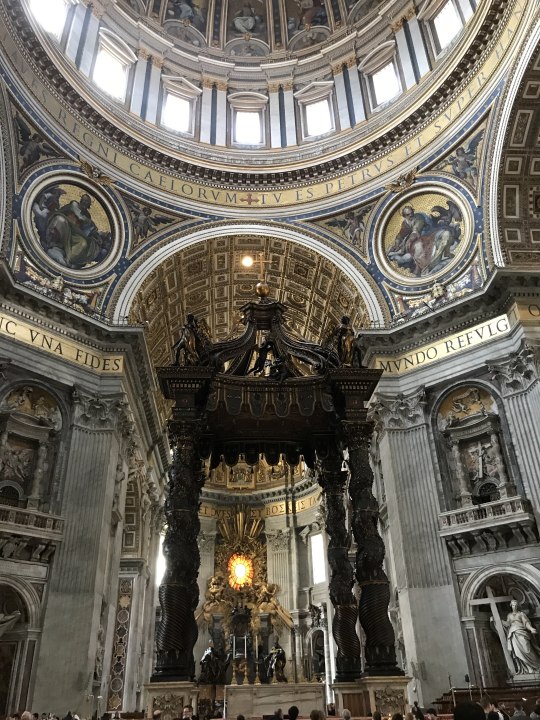
Bernini’s altar
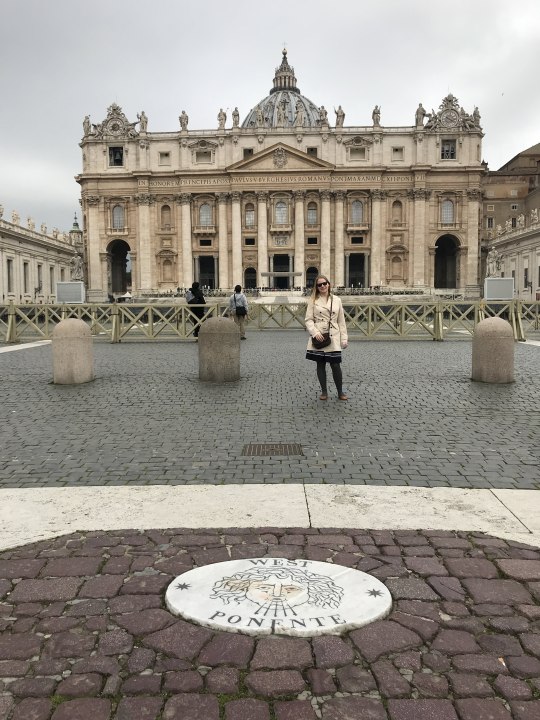
After a lunch of arancini (rice balls- I might not be able to eat the ones at Cinzetti’s ever again) and cacao e pepe (literally cheese and pepper- basically Italian mac ‘n cheese for adults), we set out to explore the city. We saw Castle Sant’Angelo (the pope fortress/Church of Illumination), Piazza Navona, The Pantheon, the Spanish Steps, and so much gelato. Eventually, we met some friends who also happened to be in Rome, and had dinner and a shared a few bottles of wine.

Gelato number two - sadly, we have no evidence of number one

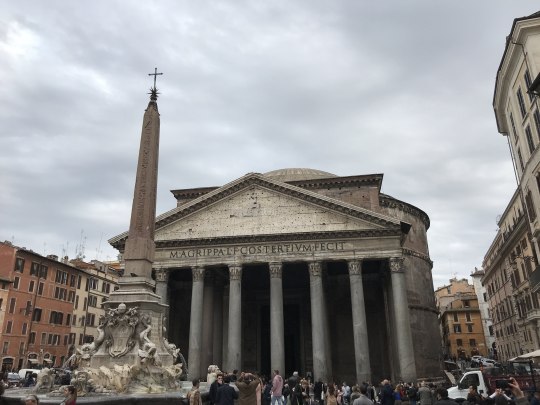
The Pantheon

These two like their Italian wine
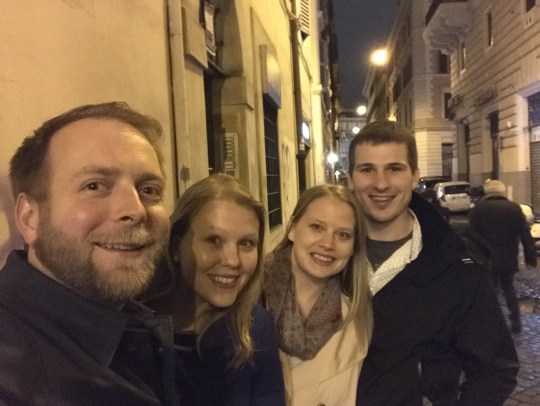
Brent and Christine happened to be in town
The next morning, we packed in some more sightseeing with the Altar of the Fatherland (Mussolini funded statue dedicated to the united Italy), Palatine Hill, the Capitoline Wolf, and Turtle Fountain (which does not have live turtles in the fountain). We ventured to the Jewish quarter of town, and had more marvelous artichokes, pasta, and possibly some of the best table bread ever (I had to take a picture it was so good). We went to a beer bar and enjoyed some brews (Italy has some good breweries), before going over to the hip Trastevere neighborhood and having more food (including a tremendous prosciutto sandwich which I would not shut up about, more arancini and a pizza) and beers. We needed to get back to the hotel, and decided to walk by the Colosseum and the Circus Maximus on the way. Unfortunately, the sky opened up and we were drenched in ten minutes… so we made a quick pit stop for more gelato to let the rain pass. There are worse things.

Remus and Romulus!


No live turtles
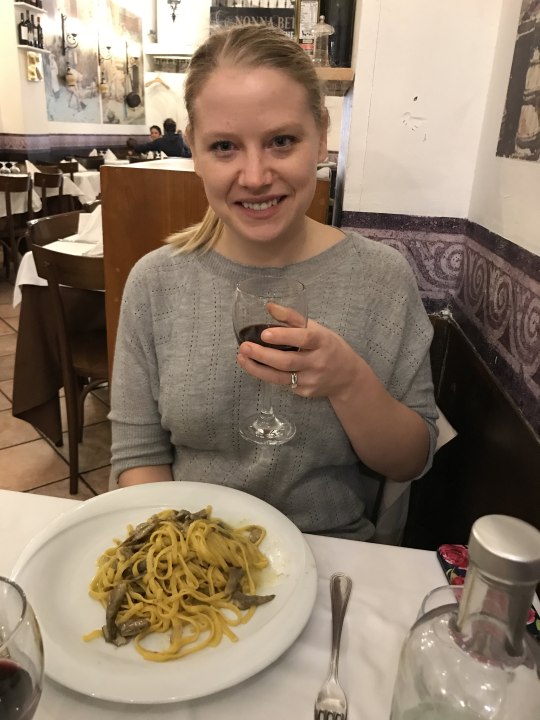

Mariah’s happy place (Gelato three of four?)
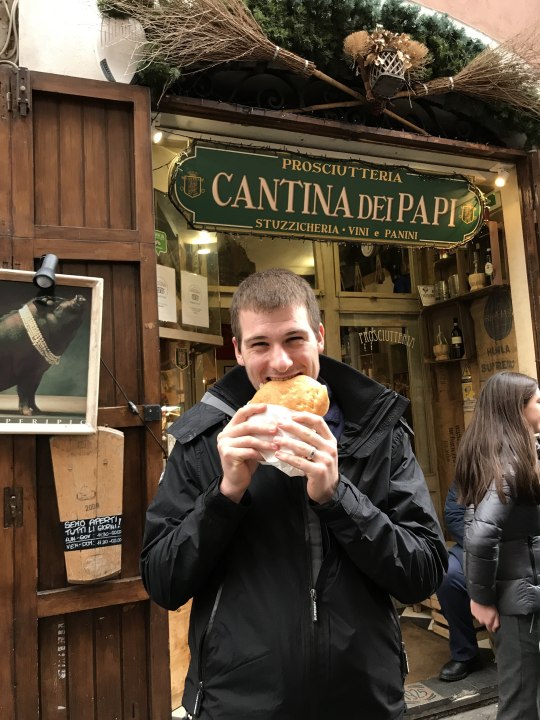
...and mine (prosciutto sandwich)

Sometimes I can get her to drink a beer

But it generally involves bribery with margherita pizza

Aaaaand it’s pouring outside

Rain keeps the tourists away - most of them, anyways
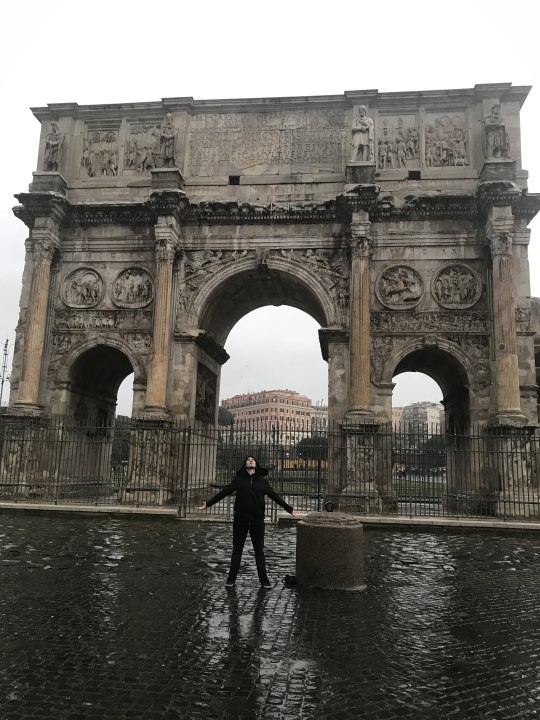
Are you not entertained?
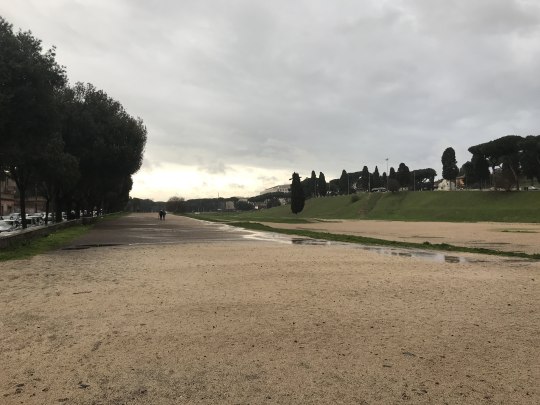
All that’s left of the Circus Maximus
We packed a ton into our Rome weekend, so in Florence (the following weekend) we were a bit more relaxed. We arrived late on Friday so our adventure really just started on Saturday morning. Our first stop was to the Cathedral of Santa Maria del Fiore, which is better known for ‘il Duomo,’ or the massive dome that adorns the church and dominates the city skyline. It was a fairly easy climb, but the vertigo is real when you are on the interior of the church and looking down. But you are rewarded with amazing art reminiscent of Dante’s Inferno (Florence is his home town, btw) and panoramic views of the city.


I hope you’re not claustrophobic... or afraid of heights!



Afterwards, we put our name down at Trattoria Mario for lunch, and killed some time at the markets before our table was ready. I don’t think you can see more leather outside of a Vegas S&M convention, but to be honest it is really cool. We stopped into a market and bought some pastries- creampuff for me and a chocolate cookie for Mariah- to hold us over. Luckily we did not have to wait for lunch long. Trattoria Mario is regarded as the best restaurant in town, and is only open for lunch. The place is tiny, and you will be seated at a two-person table with two other people and sit on stools that are made for toddlers. The bread is disappointing, but the food is marvelous. The place is meat-centric, and their specialty is the classic bistecca alla fiorentina, which is a super thick, bloody porterhouse steak. The frites were good too.

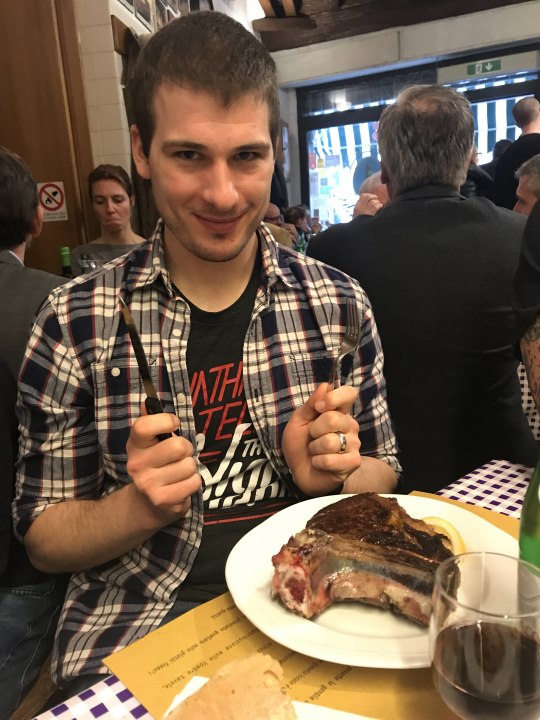
After lunch, we crossed the famed Ponte Vecchio to the other side of the city. We walked up to the Piazzale Michelangelo for more magnificent views of Florence. We walked along the river and stopped by a small tea shop, and sampled some of their goodies. We walked out with some good stuff, and an aspiration to become a tea sommelier and to (keep) travel(ing) the world. We had a rest at a dessert shop before finding dinner (easier said than done, since our first choice for dinner just never opened the restaurant for service- no notice posted physically or online), and closed the night with more beers. It was a bit early, but we have been traveling a lot.
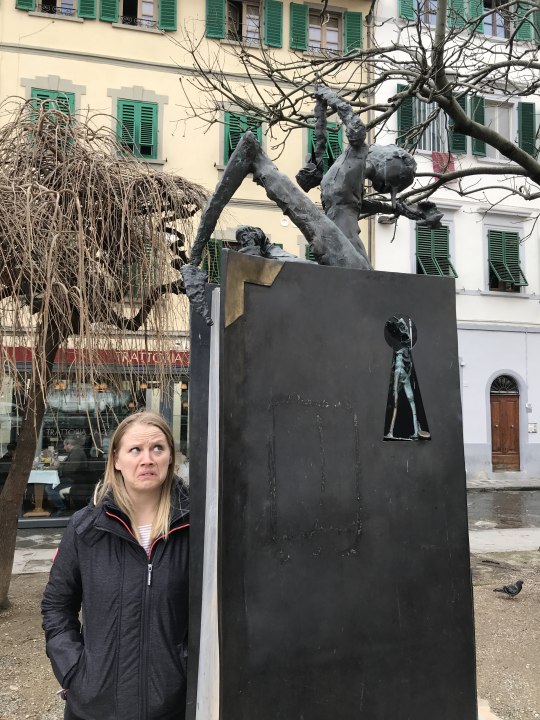
It was a pretty creepy sculpture...
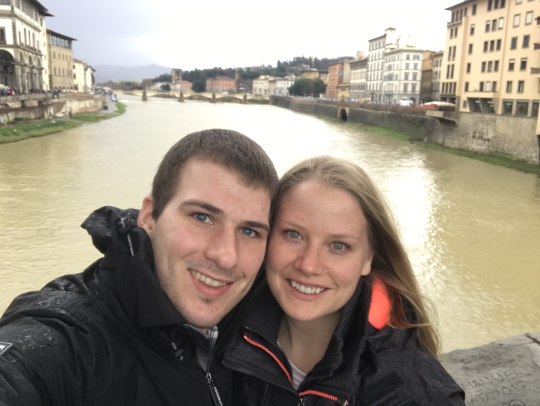


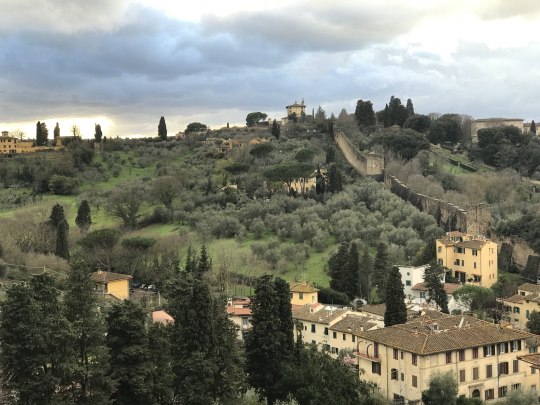
We slept in, but woke to go to the Galleria dell’Accademia, which is a museum that has nothing of much significance except for a little piece from Michelangelo called the David. Before seeing the main event, we did explore some of the other parts of the museum, including the musical instruments and some religious paintings. Two asides- first, we saw a pair of little girls (say seven) on a private guide with their parents looking at the musical instruments and throwing out some serious knowledge of the Medicis and the Renaissance art movement (the girl was a self-proclaimed art history buff, and I believe it!). Second, some of the art made to explain the dogma of Christianity is as bizarre (though simultaneously stylish) as the Thai paintings we saw in Bangkok. Seriously, if I didn’t have knowledge of the immaculate conception, I would have thought Christians believed that an old cloud god shot pigeons at a sleeping woman while some creepy dude with wings looked on approvingly.

But onto the David. It is every bit as masterful as everyone says. The story is unbelievable too. Just think, some 27 year-old just said, ‘hey, can I use that chunk of marble over there? I wanna make something for you.’ And then the Florentine people were graced with one of the most incredible works of art in history is ridiculous. Michelangelo was TWENTYSEVEN!!! Oh, and he made the Pieta before that (pictured above, from Rome).

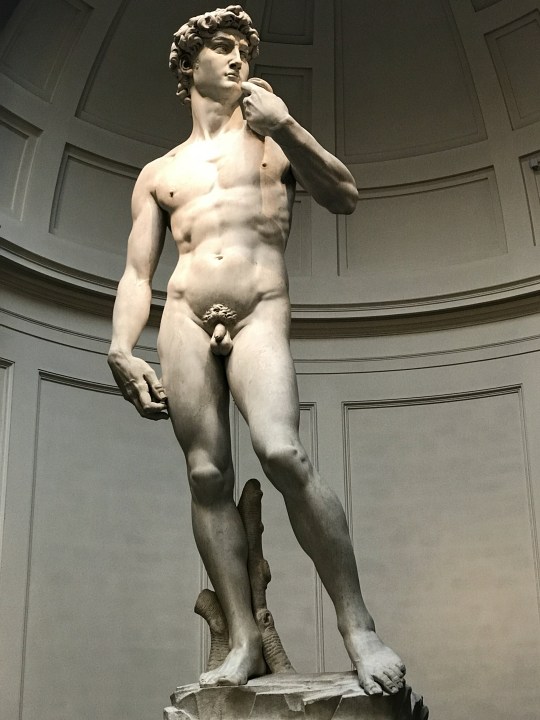
Just look at him!
Afterwards we just relaxed. We had some pizza, coffee, macarons and beers. I did grab a snack- a lampredotto. There was a stand just outside of our hotel which filled up during lunch with locals, so I figured I’d try it. The sandwich is made from spiced lamb intestine, and it’s pretty good. I mean, it’s no prosciutto sandwich, but its good. We did make our outside the Uffizi gallery before leaving, and took in some of the city’s most famous patrons before saying goodbye.


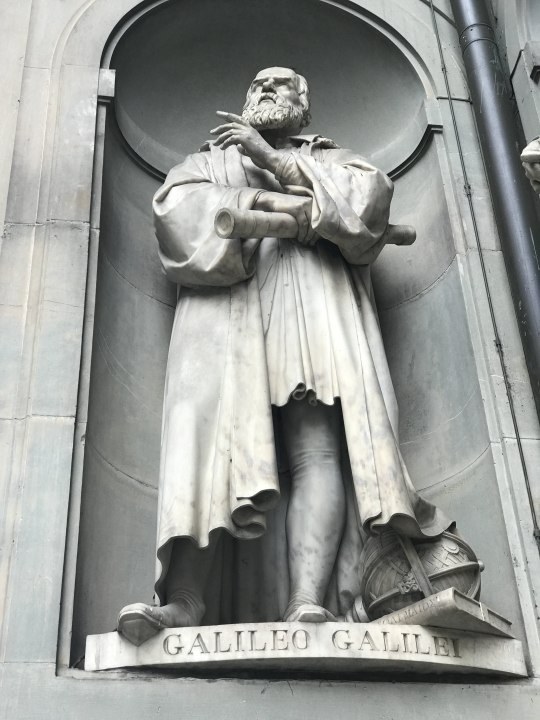
I throw my hands up in the air sometimes... singing ayo...

NBD, just our country’s namesake

Last minute snack
Italy is superb. It is a country with so many different layers of nuance and culture. Sometimes I feel people boil it down to pizza and statues, but it’s so much more. Each region, from Rome, Florence, Venice, Naples, Sicily, Milan, etc. is so different from the next. The food, outside of the tourist traps, is every bit of what makes Italian fare heralded as some of the world’s best. The culture and history is dense and rich- just think, Rome was the center of the western world through two different points of time for two different reasons. Sure, Italy has its problems and frustrations like we all do, but it is a country I will enjoy returning to time and time again.
2 notes
·
View notes
Text
nsfw tag prompts:
accepting / not accepting
@trustschaos as lauren bloom said [stripping]

he hadn't expected the show. he'd ordered her to make it pretty and enticing, sure, but to this degree? lauren is good at this -- moving her body with a smoothness he hadn't been prepared for, hips and muscles fluid in a captivating way he isn't used to.
now, lauren is always beautiful. chestnut strands fall in heavy waves down her shoulders or are confined into a skilfully braided updo, mocha irises twinkle with interest or mischief or attention, plump lips mouth the words along with her thoughts before she speaks them consciously. lauren is always beautiful, and jay often gets lost in silent appreciation of her on any given day.
but this -- the way she drops one item of clothing at a time, her body moving in time with the music in a symmetrical and seamless way that makes her seem animated -- it's new, and overwhelming. he's captivated by her, eyes scanning between her hands, hips, face, chest... there are no more coherent thoughts in his brain, his consciousness reduced to animalistic instincts and desires.
lauren is an enigma on any given day. but swaying to the song, dropping clothes to the side and exposing more skin by the second while he gapes at her? she is an angelic miracle.
before he knows it, his hands are on her hips and he pulls her in against him with a wide grin. "don't wanna wait any longer. kiss me now."
#it matters to me ; writing#to tell the truth ; answered#the war is a part of me ; jay#two sides of the same coin ; new amsterdam#the downfall and the rise ; lauren#keep away from children ; mature#trustschaos
0 notes
Text
getting to know you
tagged by @greedisgreen, @0pheliaraine, and @the-north-is-ours. Thanks guys!
Goal: tag 9 people to get to know them
Relationship status: Single. I have serious commitment issues, it’s ridiculous. Show the tiniest clue of neediness and I’m out of the door.
Favourite colour: Grey, I think? And blue. And green. Definitely black. I don’t know, anything goes.
Lipstick or chapstick: Lipstick. I rarely wear one, though.
Last song
Last song I listened to: Sex by Cheat Codes and Kris Kross Amsterdam. I cannot, for the life of me, get this song out of my head.
Last song I’d like to hear before I die: Calgary by Bon Iver. The first minute, over and over, until my consciousness fades.
Last movie
Last movie I saw: In theater? Justice League. At home, Captain America: Civil War - which by then I’d seen three times, but my friend wanted to see it and basically forced me to be the guide. She checked her phone during the best moments. Every time.
Last movie I’d want to see: American Beauty. Especially the ending.
Top 3 shows
Friends. This show is life-changing for me. I didn’t get the chance to enjoy it when it aired (I don’t think I would, given that I was a child) but watched it from first to last episode in one long weekend. For nearly two years, every time I have dinner, I watched an episode.
Game of Thrones, despite how it turned out. Season 7 made me bitter, but the show did introduce me to asoiaf, and it did excellent casting - Aidan Gillen as Petyr Baelish? I’ve been obsessed with no other man since.
Stranger Things. I rarely love stories so focused on children - worse, nosy children - but damn, these kids. And Hopper. I want to hop on Hopper.
Top 3 ships
Petyr x Sansa: Innocence and experience, schemer and dreamer, aah. I get incoherent every time I attempt to talk about this two, I can’t do them justice. I can only say I think there are no two other (fictional) persons better suited for each other, mind, body. personality, and history.
Sherlock x Irene: Brain is the new sexy. I have a thing for emotionally unavailable man who finds his one exception and obsesses over her. Pxs does this better, but damn if Sherlock and Irene are not the sides of the same coin.
Chandler x Monica: i’m still on London time. This is probably the only ship I ever want in real life. Their personality blends so well, the chemistry is off the charts, the relationship development feels so real. Ugh. I want a Chandler, but I’m just as afraid of commitment as he is so maybe I need a Monica. In the form of Matthew Perry in his prime, thank you.
Now tagging @0writerchick0 @queeenpersephone @petyrbaelish@dust-in-the-universe @redlektor @ladybaelish @catladyofthecanals @petyrbaealish @aidansplaguewind
5 notes
·
View notes
Text
Italy Day Three: Florence
After the tour I crossed the Ponte alle Grazie bridge to the downtown area and climbed up the zig zag path to Michelangelo Square. The square is mostly just a car park and a few stalls for souvenirs and a long barrier for all the tourists to hang over while taking their landscape shots over Florence. After getting my scenic photos of the city I walked back downhill and crossed back over into the city centre where I took a much needed break for a yoghurt and focaccia bread lunch and a sneaky visit to the free toilet (for proper customers only) at a large department store called Coin. I wandered back around some of the attractions from the walking tour to get better photos but the entire city seemed brimming with tourists. I couldn't move around much less try to take an unobstructed photo of something! There was a sandwich shop with two kiosks on either side of one street that had a steady line of more than 100 people on either side of the street waiting to buy one of their famous €2.50 paninis. Apparently it's a daily craze for these paninis. Insanity! By late afternoon I arrived at the Cathedral of Santa Maria del Fiore/Il Duomo di Firenze and it was quite breathtaking actually. I've not seen anything else quite like it. While cathedrals and churches can get a bit same-y after a while this one was really something new (in terms of my experiences!). The paint job was white with an intricate pattern in what looked like green and pink although it could've just been the light that made it look that colour. Perhaps if the pink was a faded red then it would be the colours of the Italian flag? I walked out of the city a little bit to San Marco Square, passing the Galleria dell'Accademia which houses the original David statue by Michelangelo, I guessed this purely based on the ridiculously long queue of tourists stretching down the road. Surprisingly the entrance ticket was only €8, with an extra €4 to be paid to skip the line. I was already exhausted from walking around all day from 8.30am to now almost 5pm and my feet were screaming so I planned a nice route back to the hostel which included the botanical gardens. However, it seems the city of Florence has no free or publicly accessible parks because at every entrance I tried I was met with a giant steel gate with spiky things on the top. Unfortunately it meant I had to walk all the way around to get back to the hostel located a stupidly long distance away from anything interesting! Back at the hostel I had to recheck in for my next night and then remake my bed with my Japanese roommate coming in right at the same time to get in my way. Finally I could rest! I read a tour guide book cover to cover then started looking into my dinner options with the standout plan for quantity relative to price would be to try one of the aperativo bars where you purchase a cocktail for €8 and then help yourself to a diverse buffet spread. I decided however, that I wasn't in the mood to do this alone so I opted instead to head to the Mercato Centrale, the Central Market, and eat at the food court there. Well what a foodcourt it was! I'd liken it to the Markthallen in Amsterdam as there were loads of stalls offering local dishes and ethnic twists as well as a huge double sided bar in the centre for anything you may want to drink. I took my time walking around each of the stalls before settling on some pasta which I ate at a dirty corner table that I was lucky to snag as it was so incredibly busy in there. A table for two was a rarity at this time of Saturday evening! I did another lap to see if there may be a dessert option but nothing caught my eye so my first plan was already to sample the best gelato in Florence which is at a place called Gelateria Dei Neri. I'd passed it a few times today and it had been packed with people but when I arrived in the evening it was almost deserted! I took my time reading through the flavours and ended up enjoying a three flavour cup comprised of caffé (coffee), caramello al burro salato (salted butter caramel), and buontalenti which is a flavour invented in the city of Florence. Needless to say it was the best gelato of my life hands down!
1 note
·
View note
Text
Reclaiming the Commons Through State Ownership? Maybe Not
Digital Elixir
Reclaiming the Commons Through State Ownership? Maybe Not
By Milan Babic, a PhD candidate at the Corpnet research group at the University of Amsterdam. He works on the implications of the rise of transnational state capital and global corporate power. You can find him on Twitter (@mbabic_1) or on milanbabic.com. Originally published at openDemocracy as part of its Decolonising the economy’series
In a 2001 essay, Naomi Klein passionately called for “reclaiming the commons” in a world increasingly dominated by corporate power and shaped by a neoliberal political logic. Almost two decades later, this very corporate power is at least up for debate; and neoliberalism is slowly being superseded by a new logic of weaponizing the existing ties of globalization instead of deepening them. At the same time, the call to reclaim the commons found an unexpected answer in the rise of transnational state ownership. Today, some of the largest FDI-transactions ever are being conducted by state-owned enterprises and sovereign wealth funds (SWFs), which are rising as the new large-scale owners of assets and equities around the world.
Some observers interpret this unprecedented rise as a direct reaction to the excesses of a globalized financial system on steroids pre-2008: state capital is often portrayed as “patient” capital, representing a welcome alternative to the volatile nature of short-term oriented equity and debt investment. Some sovereign investment vehicles like the Norwegian SWF achieved a reputation of being a role model for sustainable and alternative ways of investing in global markets. Others are being praised for their role in directing catch-up economic development in emerging economies.
But how close is this form of transnational state capital to an idea of public or common ownership? Is state ownership really a viable alternative for a post-neoliberal, more inclusive and emancipatory global economy? While this is an open question, I lay out three arguments in the following that challenge this emancipatory promise – with the hope of stimulating a discussion about the nature of the role of state ownership in a globalized economy.
Transnational State Capital Often Mimics Its Private Competitors
As has already been discussed for a while, sovereign investment tools in the global economy often “have identifiable commonalities of form and function that match the core institutions of Western financial markets”. This is not only the case for the engagement of the Norwegian SWF and Swedish AP Pension Funds in North American stock markets, but also for the immense investments of Middle Eastern funds in European multinationals and infrastructure projects. Research in progress by our CORPNET team in Amsterdam estimates that the lionshare of transnational equity investment by states is actually flowing into the core of the global economy – Eastern Asia, North America and Europe.
New evidence also suggests that states as owners are equally busy with using Offshore Financial Centers (OFCs) in order to avoid taxation or regulatory burdens, just like many of their multinational peers do. It is hence fair to say that, at least from a political economy standpoint, state investment capitalizes on and strengthens the structures and incentives of the global political economy without representing a viable alternative to existing practices.
Transnational State Capital Is Often Controlled by Domestic Elites
Forms of state ownership can be equated with “real” public ownership like in the case of most pension funds around the world. However, vehicles of sovereign investment are often rather closely tied to domestic elites who use them, amongst other things, as rent-seeking devices. A well-known example of this is the Qatar Investment Authority (QIA), which was established by the then-ruler of Qatar in 2005. While the QIA has served as a vehicle of economic development for Qatar, it is also entirely controlled by its ruling Al-Thani family.
Another example is the role that Russian multinational Gazprom plays in the advancement of the (geo-)political ambitions of the current Russian government. Research has furthermore documented the close ties between Chinese corporate and state elites in the transnationalization of state capital. A recent book shows the connection between dominant-party authoritarian elites in East Asian countries and the propensity of these states for aggressive usage of state investment in foreign corporations. These examples illustrate that some forms of transnational state investment are closely tied to the interests of domestic elites rather than being some sort of public good shared by the majority of citizens.
Transnational State Capital Is Concentrated in Large, Often Fossil-Fueled State-Owned Enterprises
While a lot of attention is given to institutional investors, we found in a recent working paper that the majority of transnational state capital is stored in majority-owned companies. This means that large state-owned enterpises (SOEs) still very much shape the landscape of global state ownership. Those are at the same time often either energy-intensive or energy-producing firms that play a key strategic role in areas like national energy security or revenue generation.
Large oil firms like Saudi Aramco, Sinopec or Rosneft, agrichemical multinationals like Syngenta or energy giants like Vattenfall are at the heart of transnational state investment. None of these large, strategically important firms has stood out in the recent past as pioneering or even advocating a transition to a green and sustainable economy and energy supply. A lot of them are, on the contrary, profiteers and carriers of a fossil-fuelled, exploitative and destructive vision of energy production and economic growth: in 2012, nationalized oil companies owned 73% of global oil and 68% of global gas reserves. This makes them rather unlikely candidates for a much-needed radically progressive stance concerning the looming environmental catastrophe.
Rebuilding the Commons After Neoliberalism
The three angles on state ownership sketched above illustrate that reclaiming the commons is not automatically going to be a progressive, let alone an emancipatory project for rebuilding our economies out of the shatters of neoliberalism – if reclaiming the commons simply means state ownership. Large public companies as well as state-invested firms and state-owned vehicles are unlikely to be the tools of a democratic overhaul of the global political economy. Two core messages follow from this:
First, a simple re-nationalization of key industries is not going to do the trick, since the rules of global capitalism, domestic rent-seeking elites and the environmental footprint of large SOEs are shaping the reality of contemporary transnational state capital.
Second, this very transnational and global reality of state capital suggests that even public ownership has become a force for globalization rather than a tool for protecting societies from its impact. The example of the “privatized” British Railways that ended up in the hands of the profiting German, Dutch and French states illustrates that reclaiming the commons cannot be just a matter of more state ownership – it needs to happen bottom-up, involve local ownership initiatives, green alternatives and the insight that we are fated to solve this issue on a global scale.
Nationalization plus protectionism, as currently advocated by many on the left, cannot be a viable, progressive alternative when the problems concern our shared global economy. Localism and an emphasis on the globalized nature of our economies might seem like a contradiction, but they are in fact two sides of the same coin: local alternatives enhance the democratic aspects of public ownership, while awareness of the global intertwinings of our economic activities ensures that we do not fall for the protectionist trap that ignores or even weaponizes these global relationships for national gains.
Reclaiming the commons locally, sustainably and democratically remains, 20 years after Klein’s call, the better alternative to a simple re-nationalization of firms.

Reclaiming the Commons Through State Ownership? Maybe Not
from WordPress https://ift.tt/2OsTGDT
via IFTTT
0 notes
Text
How much is 1000 dollars in Amsterdam?
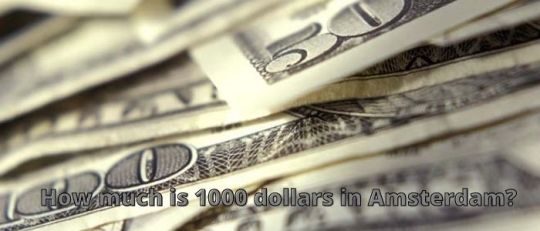
In the Netherlands, 1000 Euros is equivalent to $1164.63 USD. This information may come in handy when you're looking to convert your money and purchase things abroad. With this conversion you'll know exactly how much that new expensive camera costs or how much it will cost for a return flight back home!
The exchange rate between the U.S. dollar and the Euro is currently around 1:1, which means that you can buy 1000 Euros for $1000. But what does it actually cost to live in Amsterdam? This post will explore some of the basics of living in Amsterdam, and how much you can expect to spend on things like rent, groceries, health care expenses etc.
In Amsterdam, you can get 1000 dollars for 1063 euros.
How many dollars is $100 euros?
So, you're going on vacation and want to know how much money to bring with you. You might be tempted to just convert all your euros into dollars before deciding what's enough for the trip, but there are a few things you need to consider first. First of all, some currencies are worth more than others - so 100 Euros is not the same as 100 dollars! Second of course is that conversion rates can change over time. For example if you got lucky and converted at 1:1 it would take $150 USD for €100 Euros today; but if we wait too long it will probably only take about $125 USD per €100 euros. The most important thing though is whether or not your bank charges an exchange rate fee when converting currency. Click hare
1. One hundred euros is equal to about $110
2. The exchange rate changes daily, so you might want to check the conversion before making a purchase
3. Euro bills come in denominations of 5, 10, 20, 50 and 100 euro notes
4. There are coins that come in 1 cent (penny), 2 cents (nickel), 5 cents (dime) and 10 cents (quarter) values as well as 1 euro and 2 euro pieces
5. Euros have some interesting symbols on them - one side has a map of Europe with 12 stars around it while the other has an image of a kangaroo surrounded by palm leaves
I was once taught in a class that there are around $1.25 U.S. dollars for every $1 dollar European Euro, but I'm not sure if that's still true today because the currency exchange rate fluctuates constantly.
How much is a Dutch Dollar?
The idea of a Dutch dollar is probably not something you've heard about before, but it actually exists. To get to the bottom of this topic, we first need to go back in time and see what was happening with currency at the time. In 1750, King George II ascended to the throne and set about reforming Britain’s currency by making coins with higher silver content that could no longer be clipped or shaved. This led to a shortage of small change which resulted in people using foreign currencies such as Spanish dollars rather than British ones. The term ‘Dutch dollar’ was coined for these coins when they were brought into circulation in Ireland from Holland where they had been minted since 1690 – hence its name!
1. A Dutch Dollar is equal to 100 cents
2. The United States dollar is worth more than a Dutch Dollar because it has more value
3. There are coins that represent 1, 2, 5, 10, 20 and 50 cents
4. There are also coins that represent 1 and 2 euros
5. Euros can be used anywhere in the European Union (EU) but not outside of the EU
6. The euro was introduced on January 1st of 1999 as part of an effort to create a single currency for many European countries and make transactions easier across borders
The Netherlands has a currency called the gulden. One dollar equals four and one-half guldens.
How much is 1 euro to 1 US dollar?
This article will show you the exchange rate between 1 euro and 1 US dollar. We want to help our readers make informed decisions about their money, so we are providing this information for your reference. Most people use Euros in Europe or Pounds in England, but it's important to know how much each of those currencies is worth when converting them to a common currency like USD.
This blog post will answer the question of how much is 1 euro to 1 US dollar. It is an important question for many people traveling abroad and it can be quite difficult to convert currencies when you are not in your home country. There are a few different methods of conversion which this blog post will explore.
The euro is worth $1.16, and the US dollar's current value is 1.22 euros
What is the strongest currency in the world?
The strength of a currency depends on the size and stability of the country's economy. There are two main factors that determine how strong a currency is: Purchasing power parity (PPP) and international reserves. For example, China has been printing money to keep up with its economic growth which has caused inflation in their domestic markets. This means that it takes more Chinese yuan to buy an imported good, making imports from other countries cheaper for them than they would be if China had stable prices. Countries with low PPP compare favorably internationally because they can purchase goods themselves more cheaply then others due to price differences in local currencies.
If you want your blog post intro paragraph to engage readers this is what you need to do!
There are a lot of different currencies in the world, but there is one that stands out. It's called Bancor and it was designed to be stable and interchangeable between any other currency.
Conclusion:
The answer to this question is dependent on the exchange rates. For example, if you are converting from Euros to US Dollars, one Euro will be equal to $1.13 USD as of December 2016. If you want a more accurate value for 1000 dollars in Amsterdam, we recommend using Google currency converter or another free online tool like XE Currency Converter or Oanda Exchange Rates and let us know what your findings were!
0 notes
Text
Two Sides to The Same Coin
read it on the AO3 at https://ift.tt/2VjctCI
by SpiderRen
Multi-Verse Au-Spiderman
Prologue: Earth 200000
Penelope Parker was a regular 16-year-old girl living in Queens, New Amsterdam. She was bitten by a radioactive-spider at Oscorp when she was 12 and became Spiderling. Corse her life turned around from there and was bad before it was good.
Book 1-Intro
Book 2-Infinity War
Book 3-Endgame
*I wrote this story over on Wattpad and I decided to transfer the story over to Ao3 and see if people would like it*
Words: 400, Chapters: 1/41, Language: English
Fandoms: Spider-Man (Tom Holland Movies), Marvel Cinematic Universe, The Avengers (Marvel) - All Media Types
Rating: Teen And Up Audiences
Warnings: Graphic Depictions Of Violence, No Archive Warnings Apply
Categories: F/M, F/F, M/M
Characters: Penelope Parker(Oc), Peter Parker, Tony Stark, Pepper Potts, Happy Hogan, Steve Rogers, James "Bucky" Barnes, Natasha Romanov (Marvel), The Avengers - Character
Relationships: Pepper Potts/Tony Stark, Peter Parker & Tony Stark, Penelope Parker & Tony Stark & Peter Parker, Penelope Parker (OC), Penelope Parker & Peter Parker
Additional Tags: Penelope Parker is from another universe, Alternate Universe, Tony Stark Acting as Peter Parker's Parental Figure, Peter and Penelope sibbling relationship, pepper potts is the best, Brother-Sister Relationships, Father-Daughter Relationship, Mother-Daughter Relationship, Father Figures, Peter Parker Needs a Hug
read it on the AO3 at https://ift.tt/2VjctCI
0 notes